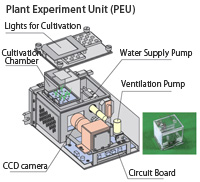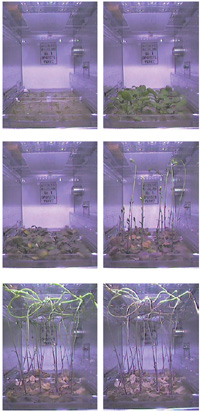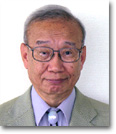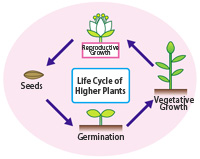This is an archive of information released in the past.
Disclaimer: It may contain broken links or outdated information. Some parts may not function in current web browsers.
*Visit https://humans-in-space.jaxa.jp/en/ for the latest information.

Experiment
- News
- Kibo Utilization Strategy
- Kibo Utilization Plan
- List of JAXA's Utilization Themes
- Experiment Facilities
- Space Environment Utilization
- Archive
News
- Experiment completed (November 12, 2009)
Background
Living things born on earth lived for long time in water, in which the effect of gravity is relatively small. Million years ago, the ancestors of land plants were born. There are several reasons why plants could evolve to be able to grow on land.
First, plants have been able to respond and adapt to the effects of gravity under their environment. Plants are spreading their roots under the ground to absorb water and nutrients, and expanding stems upward for the photosynthesis. Plants are using the gravity signal to determine the growth direction of such roots and stems. In addition, plants have strong cell walls to prevent their stems from falling down. How could plants grow in space without gravity ? Could plants germinate, make flower bloom, and make seeds for the next generation, same as on the earth (Figure 1) ? These days, many countries are competing to perform space experiments to study the effect of gravity on the life cycle of plants.
Objectives
Arabidopsis thaliana has a relatively short life cycle, around 50 days from germination to getting mature seeds for the next generation. In addition, it is the first higher plant which genome was completely sequenced, and we are able to analyze the effect of gravity on its life cycle on genetic level. In this experiment, the effect of gravity on life cycles of Arabidopsis thaliana, including the growth of leaves and stems, fertilization, embryogenesis, and seed formation, will be studied with a focus on changes in the plants' morphology and function, in relation to changes in gene expression. "Space seeds" returned to the ground will also be germinated for observation of subsequent growth.
This experiment has another purpose, which is to study plants' cell walls. We will study how the expressions of genes involved in cell wall formation are changed in each stage of the plant's life cycle under the microgravity environment.
Experiments

Figure 2. Plant Experiment Unit

Figure 3. Growth of Arabidopsis Thaliana
Arabidopsis thaliana will be cultivated in the transparent plastic chamber (about 5cm H × 5cm W ×5cm D) in the PEU (Figure 2). The chamber uses rock wool (inorganic fiber processed into blocks) to serve as soil. The seeds will be sown on the fiber, and launched in dry condition. The PEUs will be installed both in the Microgravity Compartment and 1G Compartment of the Cell Biology Experiment Facility (CBEF) in Kibo to study the effect of gravity. Once the units are delivered installed in CBEF, water will be supplied to the rock wool by commands from the ground, and the experiment will begin.
The unit has an LED matrix for lighting. An infrared-water sensor monitors the amount of moisture in the rock wool to supply water automatically when it is dry. A ventilation pump turns on to reduce humidity when the humidity sensor in the cultivation chamber detects a high level of humidity. CCD cameras will get the image of plants and send them to Tsukuba for the ground monitoring. After the CCD camera captures particularly the growth of leaves and stems during the vegetative growth period, as well as the formation of flowers and pods during the reproductive growth period, plant samples with seeds under refrigeration will be returned to the ground to study their morphology. Some of the plant will be brought back to the ground after being chemically fixed and frozen for analysis on a genetic level. In addition, the germination rate and subsequent growth of the space seeds will be observed. The mechanical properties of cell walls will also be analyzed in relation to changes in the expression of genes involved in cell wall formation.
Main Points of This Experiment !
Two-week space shuttle missions are too short to conduct experiments, such as the one for plant life cycles that takes six weeks at the earliest. The long duration ISS mission enables this long-term experiment.
This experiment will provide basic information that is important in understanding the effect of gravity on plant life cycles, as well as future plant cultivation in space.
The Plant Experiment Unit (PEU) developed by Japanese teams is a very small box of 13 × 21 × 8 cm. It is a self-sustained "miniature plant factory in space" equipped with the 5 × 5 × 5 cm cultivation chamber, the lighting system, the ventilation pump, the water supply pump, and the CCD camera. The unit can be activated anywhere simply providing the electric power.
Organization
 |
Principal Investigator (PI)
Seiichiro KAMISAKA Visiting Professor, Graduate School of Science and Engineering, University of Toyama |
| Copyright 2007 Japan Aerospace Exploration Agency | Site Policy |
